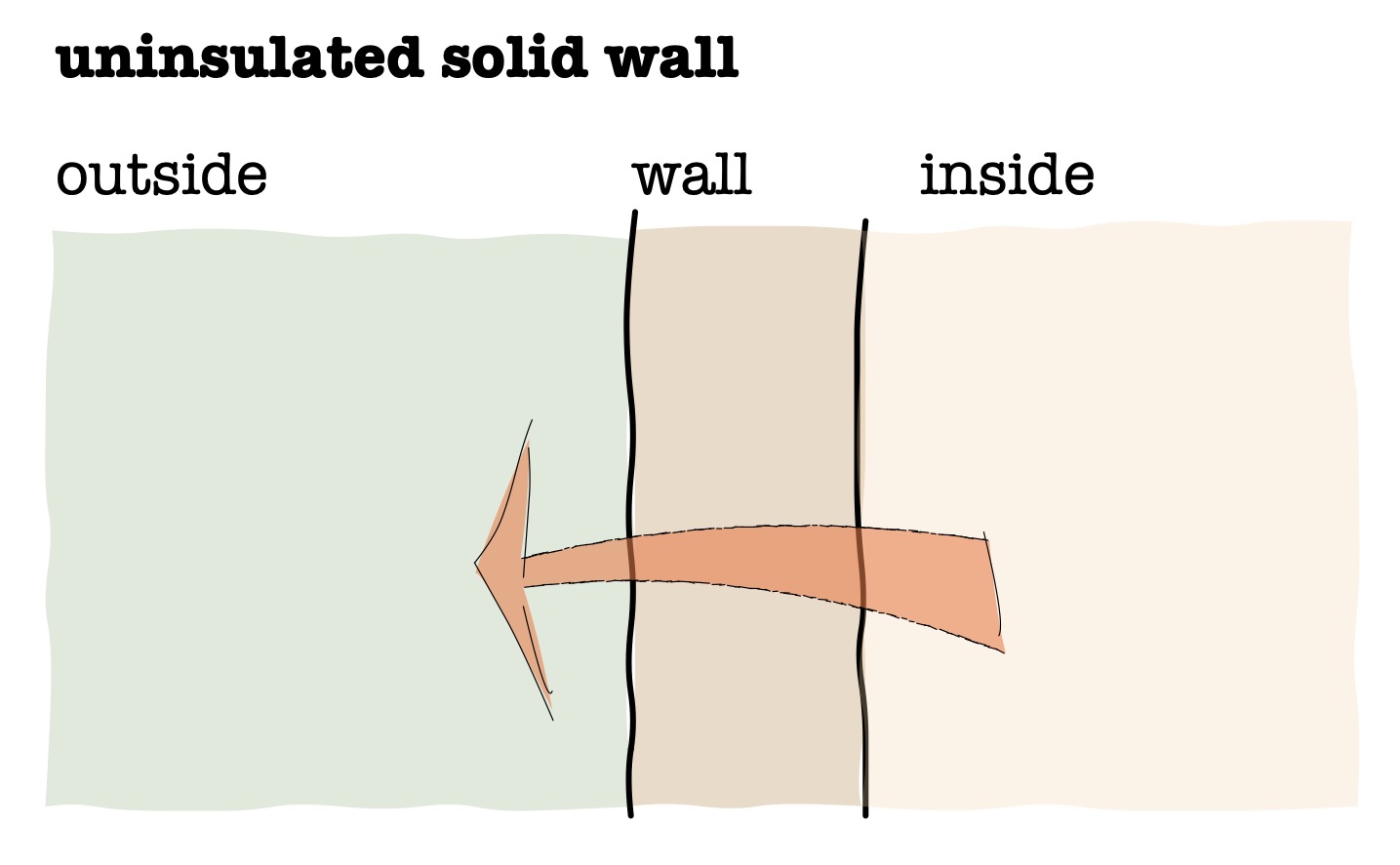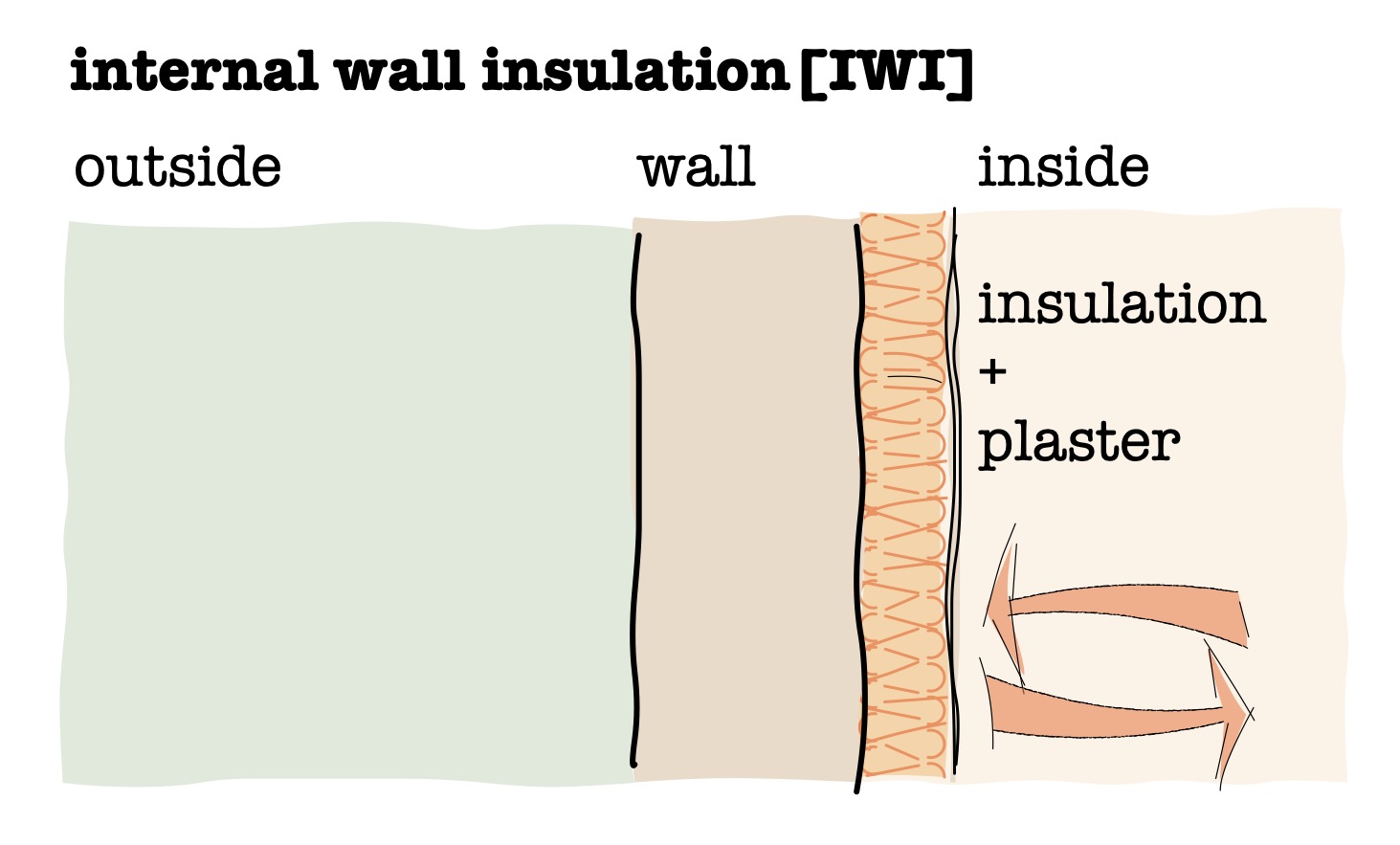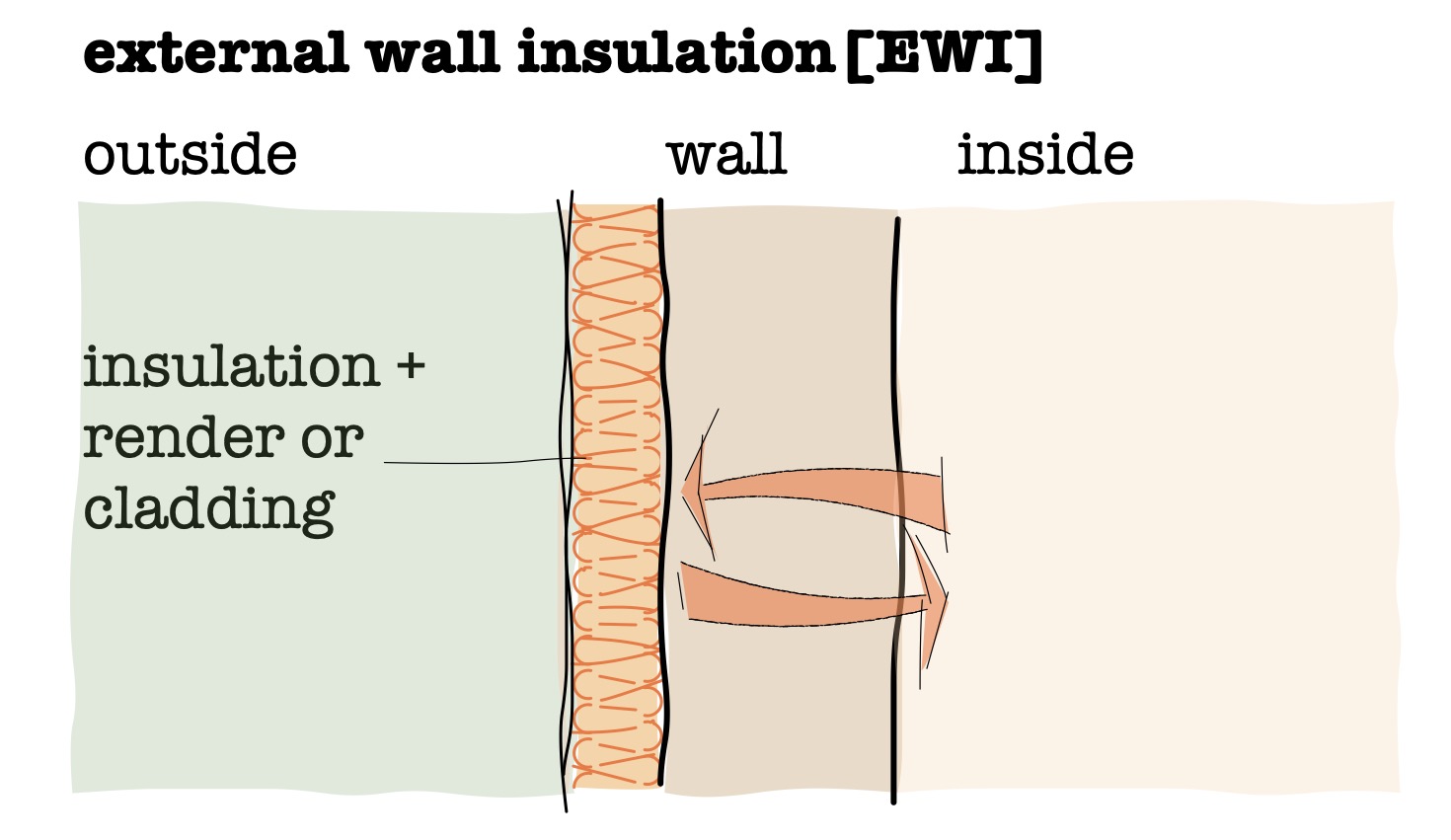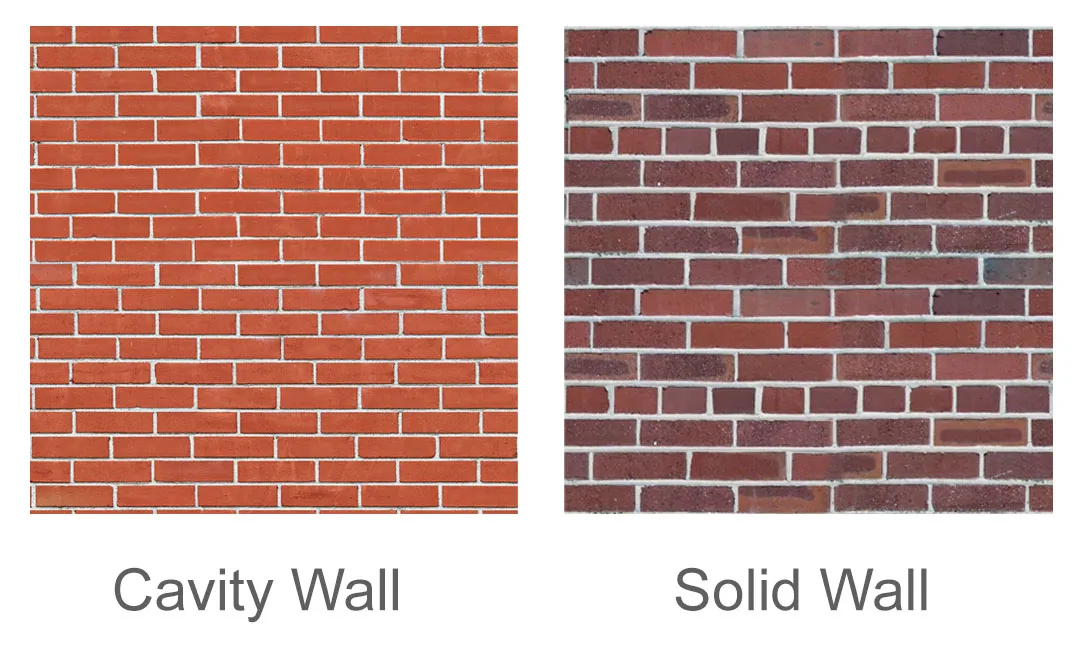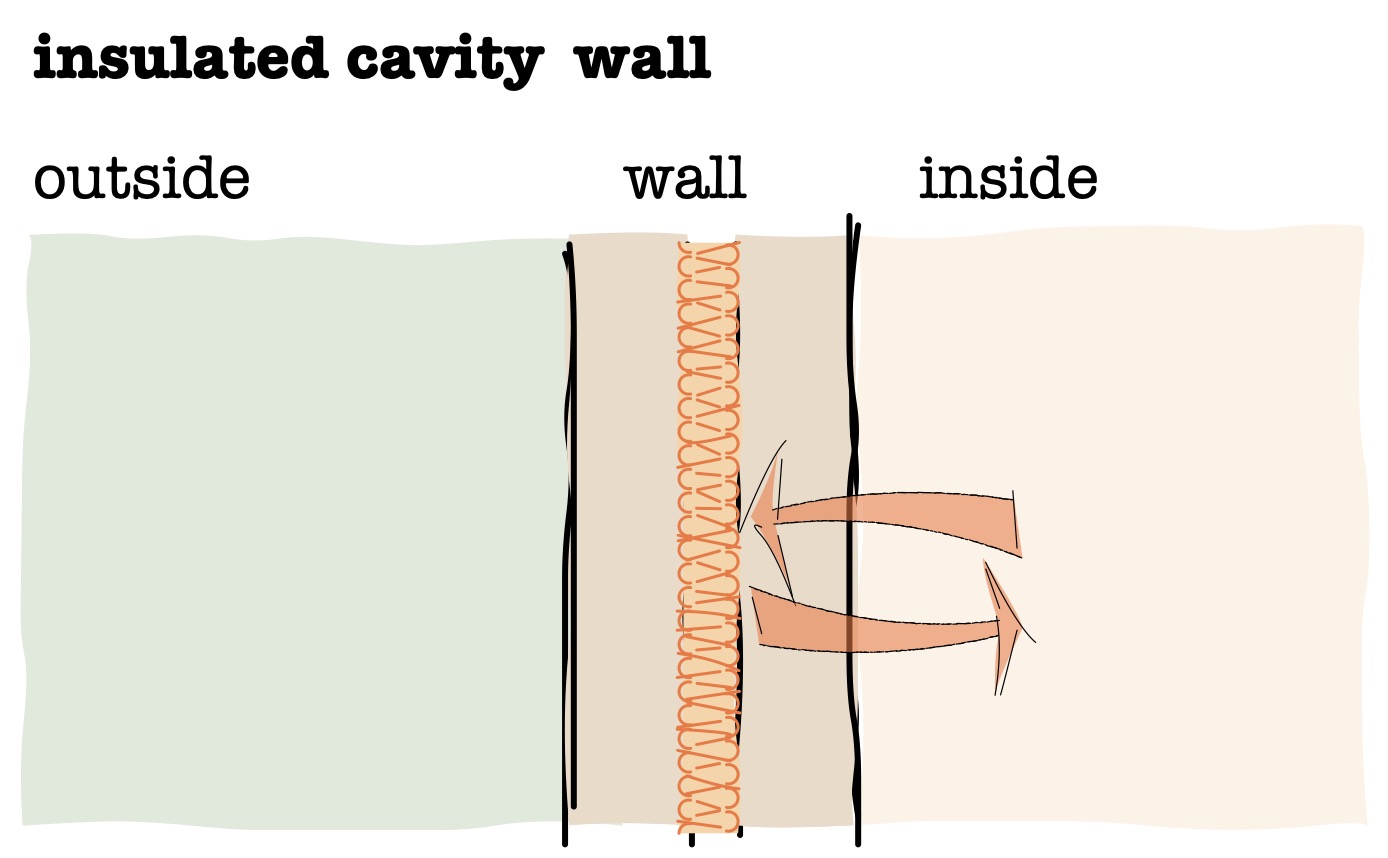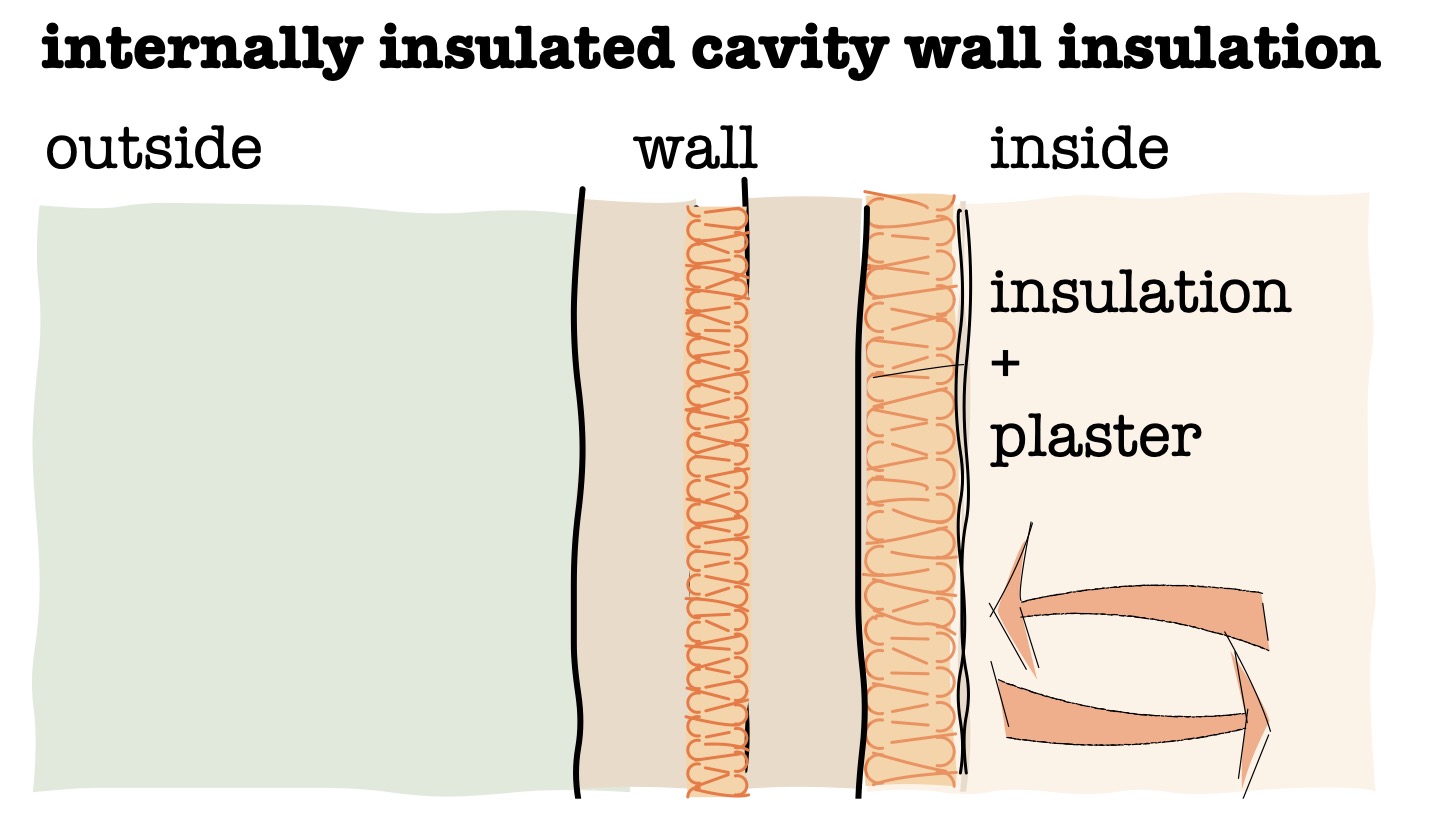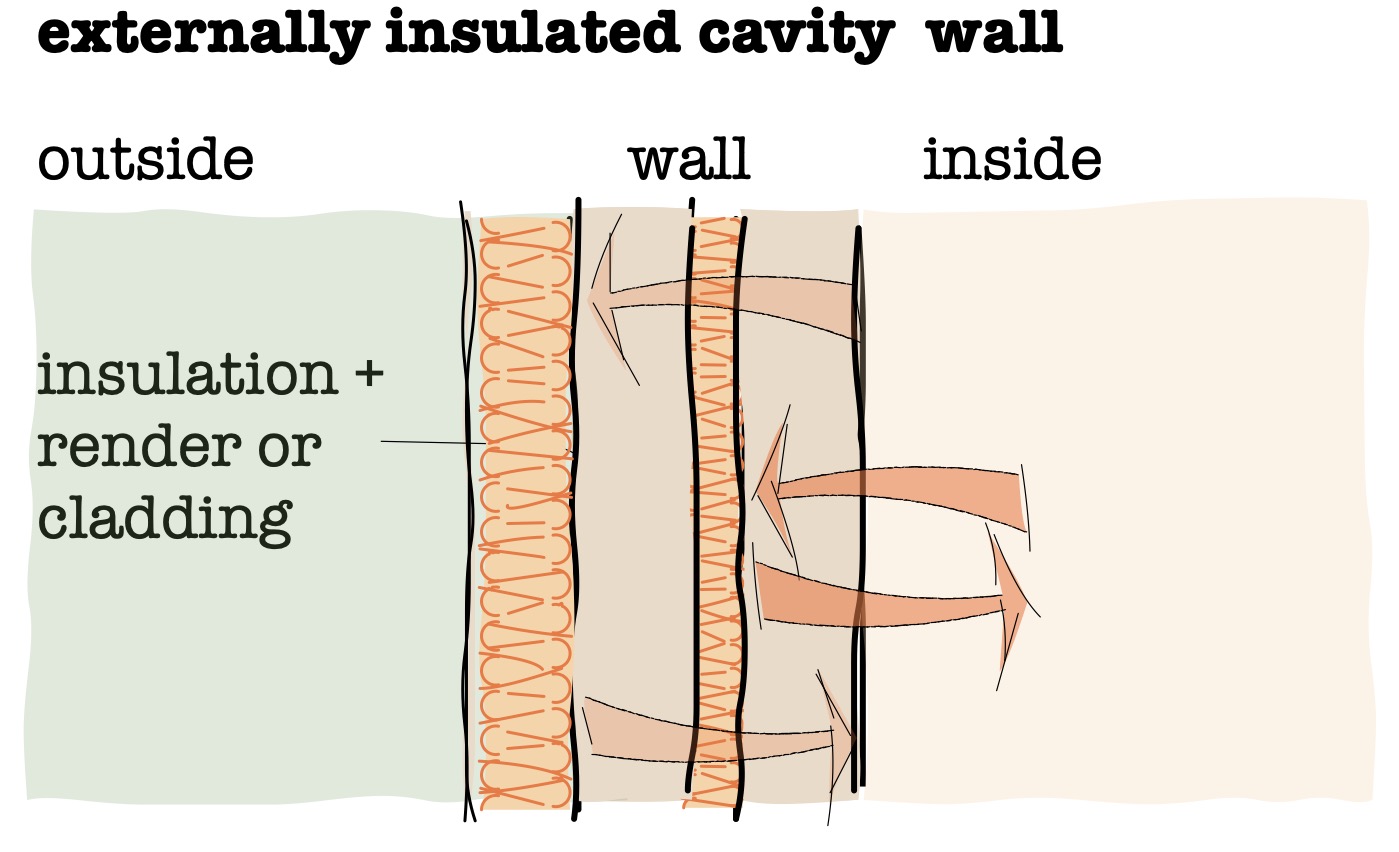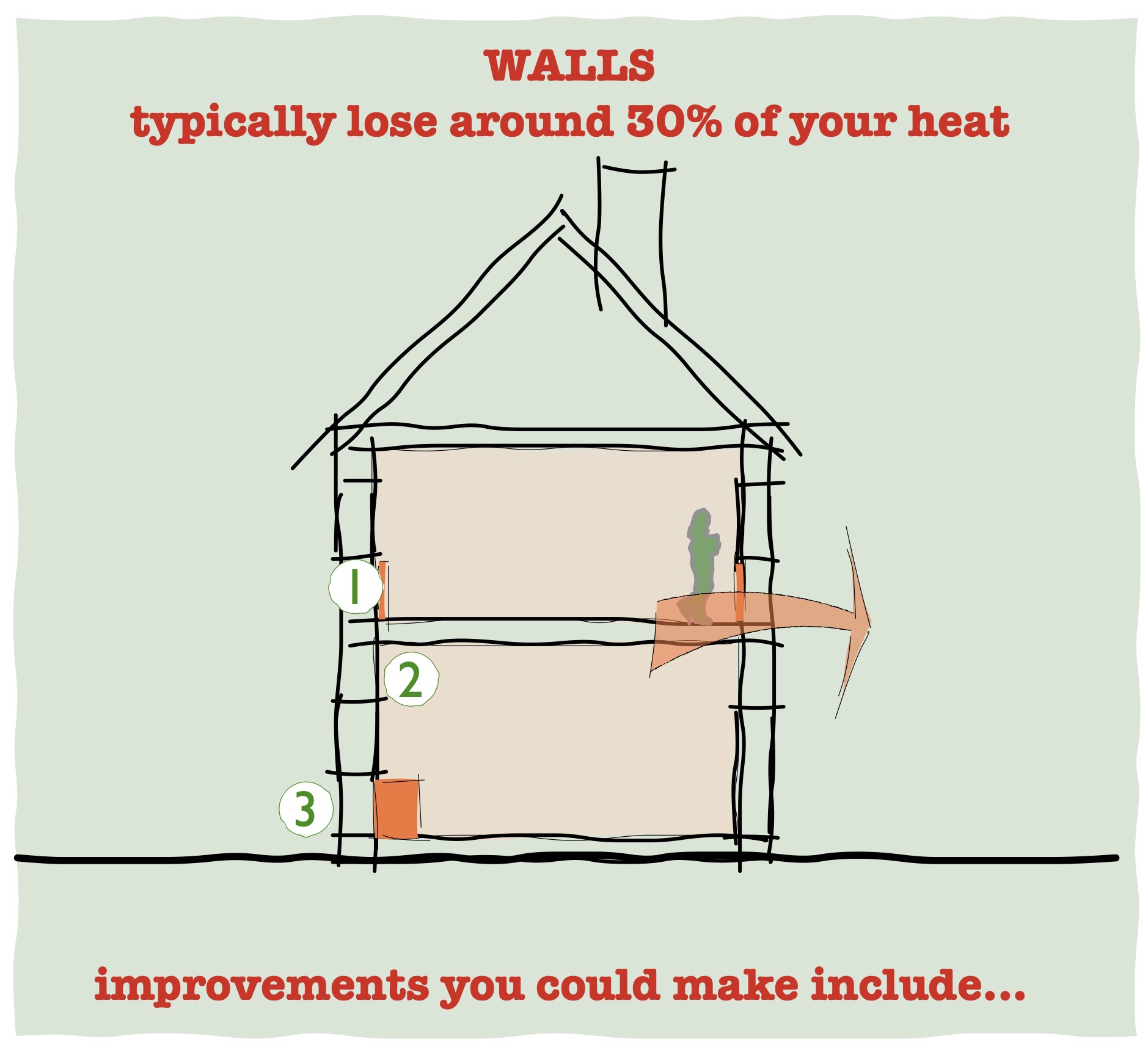
Solid Walls
Most houses built before the 1920’s have solid walls, of brick, stone or a combination of both, which are very poor insulators, and would ideally be insulated internally or externally.
However, this can be very difficult and costly, or even impossible, due to Listed Building or Conservation Area constraints, if they apply.
Solid Walls + Internal wall insulation [IWI]
To have any significant effect on your energy use, and to warrant the disruption, internal wall insulation will probably need to be 50mm-100mm [2″-4″] thick. This will impact the useable area of each room, though for bigger rooms this would obviously be less significant.
There is a wide range of possible materials, but generally it’s better to use ‘breathable’ materials, which reduce the risk of trapping moisture, which can cause damp, mould growth, etc.
Many Georgian houses have internal features of heritage value, like plaster cornices, moulded skirtings, etc. These will need to be reproduced where listed building consent is granted.
Warning: Professional advice is advised if considering internal wall insulation, to avoid potential condensation problems, and to deal with heritage issues.
Solid Walls + External Wall Insulation [EWI]
For many 18th and 19th Century properties, External Wall Insulation will be impossible, for heritage reasons.
In exceptional circumstances, eg when a modern wall of lower heritage value has been added to the house, it may be worth considering, as it is likely to be less disruptive, and costly, than Internal Wall Insulation.
Warning: Professional advice is advised if considering external wall insulation, to avoid potential condensation problems, and to deal with heritage issues.
Solid Walls > Cavity Walls
Houses built since the 1920’s generally have cavity walls. Although providing a small thermal improvement by the trapping of air in the cavity, the intention was to stop rain penetrating the walls, combined with damp-proof courses preventing rising damp. Thus, cavity walls should be drier that most solid walls, and lead prone to condensation.
Cavity walls were predominantly built of brick, although concrete and other blockwork came into use, normally rendered externally.Cavity walls can be easily detected if the outer skin is brick – see illustrations opposite. Where rendered, they would need to be assessed professionally.
Cavity Wall Insulation
Most cavity walls have already been insulated, over the last few decades. But, as long as the wall construction is of a reasonable quality, and the wall ties holding the 2 skins of masonry are not corroded, then cavity wall insulation is a well-established way of providing a small amount of additional insulation to your home.
Warning: a reputable company should be used, as there are pitfalls which can arise from poor installations.
Internal wall insulation
To have any significant effect on your energy use, and to warrant the disruption, internal wall insulation will probably need to be 50mm-100mm [2″-4″] thick. This will impact the useable area of each room, and with decreasing room sizes over the 20th Century, this will become a more significant issue..
There is a wide range of possible approaches, but generally it’s better to use ‘breathable’ materials, which reduce the risk of trapping moisture [which can cause damp, mould growth, and lasting damage].
Warning: Professional advice is advised if considering internal wall insulation, to avoid potential condensation problems, and to deal with heritage issues.
External Wall Insulation
Properties from this era can be suitable for External Wall Insulation, particularly if the external wall finish is not considered aesthetically valuable.
EWI has the potential to achieve the optimal level of insulation, particularly if combined and linked with warm roof insulation, to achieve the ‘duvet’ effect seen by many as the thermal ideal.
Whilst not a cheap option, EWI may be worth considering, as it is likely to be less disruptive, or costly, than Internal Wall Insulation [IWI].
Warning: Professional advice is advised if considering external wall insulation, to avoid potential condensation problems, roof over-hangs, etc.
Timber-Framed Walls
Increasingly over the last 50+ years, external walls have been built using structural timber frame, although examples are rare in Widcombe.
Timber-frame walls have the advantage of allowing additional insulation to be incorporated within the thickness of the wall. This has developed over this period, as building standards have increased. In brief, the newer the house, the better the insulation should be. However, moisture control becomes critical, to avoid condensation and dampness in the structure causing rot.
Additional Internal [IWI] and external [EWI] insulation can be introduced, but only with careful design to avoid these damp problems occurring.
Renewable Energy Suppliers
With the increasing conversion of the national grid to renewable energy generation, perhaps the best strategy to reduce carbon emissions [after converting heating to an electrical source], is to switch to a 100% renewable supplier. See online comparison sites – e.g which?.
However, some home owners are keen to generate their own renewable power, via Solar PV, wind or even water power.
Solar PV
Solar Installation costs are reducing year by year, and therefore becoming more attractive to home-owners. A small array of panels – up to around 3.5kWp [the measure of peak output on a sunny day] will normally be possible without prior approval by the power supplier.
This may comprise some 10 or so panels, approx 1.7m [5’6″] x 1m[3’3″]. Fitting these onto existing roofs, preferably on a south-facing slope, may be challenging. Any reputable local supplier [registered with MCS] can advise on this, and there are many on-line tools which may help. MCS-certified installers can be found here.
Listed Building Status will likely limit the options for Solar PV. Ensure you check with B&NES conservation dept, or get advice via the links below.
Wind power
This is a far less likely source of generation in most urban locations, and needs specialist advice -e.g Retrofit West and BWCE – see Home Assessments drop-down below.
Water power
Unless your property is next to a water-course, this is unlikely to be an option, and even if it is, would be a very challenging process !
Heat Pumps
Air Source Heat Pumps [and ground-source and water-source] extract the heat in the surrounding environment, by means of electric-powered heat pumps . Their efficiency, measured as the SCOP – Seasonally adjusted Co-efficient Of Performance – determines how much of this heat energy they extract.
Heat Pumps, can be powered from solely or mainly renewables, via a renewable tariff [see above]. We have more information on heat pumps here and here
A common myth is that heat pumps only work with smaller or better insulated buildings. Whilst true that they work better in that situation, virtually no buildings cannot be heated by heat pumps. Click the following link for a fairly extreme domestic example, though be aware this is effectively an advertisement, and cannot therefore be endorsed by GGW… YouTube link
Widcombe contains many Listed Buildings, which present special challenges to retrofitting, as any improvements that are judged by the Local Planning Authority [LPA] to affect the character of the building will need Listed Building Consent [LBC].
Historically, this has led to clashes between the aims of energy conservation and heritage conservation. However, recent changes in policy resulting from the climate crisis are placing greater emphasis on energy efficiency to reduce carbon emissions.
B&NES Advice
Every Listed Building presents a unique set of circumstances, and requires assessment by the LPA’s [B&NES] conservation team.
In response to the Climate Emergency, B&NES Council has developed a new level of pre-application advice, unique in the UK, to help owners of Listed Buildings to make them more energy efficient.
This ‘Service Level Zero’, unlike a standard pre-application, does not require a proposal and is aimed at homeowners who are interested in improving the energy of their listed building but don’t know where to start.
This service is for owners and occupiers of Listed Buildings within Bath and North East Somerset who are looking at ways to improve the energy efficiency of their building. The Conservation Officer will visit the site and provide tailored technical and conservation advice based on your property and the suitability of measures discussed, as well as any other factors such as budget. This service is suitable for the following:
- Solar panels.
- Energy saving ‘quick wins’ to save energy and water which may not require Listed Building Consent
- Draughtproofing
- Secondary glazing and/or slim-profile double glazing
- Internal wall, loft, and/or floor insulation
- External wall insulation
- Upgrading of existing heating and hot water systems
- Heat pumps
BWCE Guidance
Bath And West Community Energy, a not-for-profit partner of GGW, work closely with B&NES in this field:
Widcombe lies within the Bath Conservation Area – see below.
This applies another set of planning rules, whether your building is listed or not.
Whilst generally less restrictive than Listed Building status, external changes to a property may well be constrained if they are seen as affecting the character of the area, distinct from the character of the building itself.
In Bath, we also have our World Heritage Area and Cotswolds AONB status, although these are less likely to affect the acceptability of retrofit projects.
To check the Bath Conservation Area and other planning area boundaries, click this link:.
Whilst a few retrofit measures such as draught proofing and loft insulation are suitable for residents to undertake by themselves, or with the help of local tradespeople, in some cases without needing consent, the majority of measures, particularly to older buildings, need professional advice and guidance.
This is necessary to avoid creating new problems, such as reducing uncontrolled ventilation [ie. draughts !] and increasing moisture within the building – potentially very damaging.
Several local Not-for-Profit agencies offer low-cost Home Energy Surveys. These include two of our key partners – RETROFIT WEST and BWCE – see links below for their current offers. GGW strongly advocates such surveys, as a way of providing expert advice and assistance on your ‘retrofit path’…
